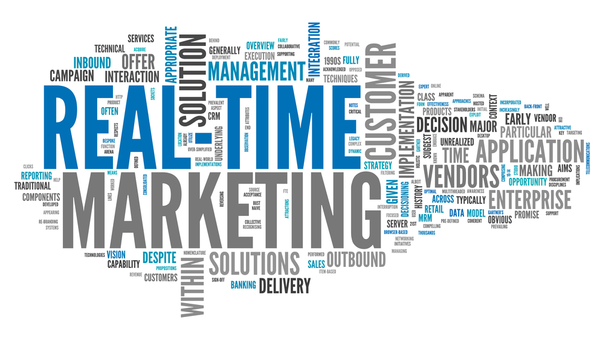Just a few years ago, customers would wait 24 hours for an email or callback.
Today it’s NOW – or nothing… along the whole customer journey.
All businesses face similar scenarios:
It’s 3am and your call centre’s a wasteland…
It’s Sunday afternoon and a hot-prospect customer has three questions that’ll entice him further down the sales funnel…
It’s lunchtime and 100 people click Contact on your website – but it’s your lunch hour too, so you don’t answer straightaway…
All of these are problems – because customers all want responses right now.
Welcome to 2016, where real-time marketing isn’t a nice-to-have: it’s a mandatory.
And autoresponder emails or pop-up chat windows aren’t as complete an answer as they were just five years ago.
But according to the new Oracle Marketing Cloud/Econsultancy Cross-Channel Marketing Report 2015 just 26% of marketers believe that real-time customer experience is ‘fundamental’ to their business.
So what’s causing this cavalier approach to the customer’s time? Is it deliberate? Certainly not.
In the same report, 92% of businesses saw providing a superlative customer experience as vital. And real-time responses are part of that.
Perhaps the gap is in understanding what real-time is and how it can drive real results.
The report suggests that four questions matter. Answer all of them and you’re on your way to real-time success.

Today it’s NOW – or nothing… along the whole customer journey.
All businesses face similar scenarios:
It’s 3am and your call centre’s a wasteland…
It’s Sunday afternoon and a hot-prospect customer has three questions that’ll entice him further down the sales funnel…
It’s lunchtime and 100 people click Contact on your website – but it’s your lunch hour too, so you don’t answer straightaway…
All of these are problems – because customers all want responses right now.
Welcome to 2016, where real-time marketing isn’t a nice-to-have: it’s a mandatory.
And autoresponder emails or pop-up chat windows aren’t as complete an answer as they were just five years ago.
But according to the new Oracle Marketing Cloud/Econsultancy Cross-Channel Marketing Report 2015 just 26% of marketers believe that real-time customer experience is ‘fundamental’ to their business.
So what’s causing this cavalier approach to the customer’s time? Is it deliberate? Certainly not.
In the same report, 92% of businesses saw providing a superlative customer experience as vital. And real-time responses are part of that.
Perhaps the gap is in understanding what real-time is and how it can drive real results.
The report suggests that four questions matter. Answer all of them and you’re on your way to real-time success.
1. Is the customer experience optimised to the device?
Your website remains at the heart of your online marketing – but with 4.9bn mobile devices connected to the web, mobile isn’t optional.
That means optimising for all sizes of screen. And sometimes, for no screen at all.
The user experience on a 4” phone screen isn’t a smaller version of a 15” laptop. It’s fundamentally different.
Choices are much more limited; the information that can be packed onto a page is far briefer.
The best optimisation of a site for mobile isn’t so much a cut-down as a complete re-imagining. So first, make a list of all the devices customers are using to visit your site and build the customer experience that works for each one.
And why does this matter to real-time? Simple: devices are personal. People carry them along; keep them in their pockets; sleep with them nearby.
When a customer makes an impulse purchase or has an urgent question, a mobile device is odds-on favourite to be the way they connect.
A full 37% of purchases now come through the mobile channel. So optimise.
2. Do your actions treat the customer as an individual?
Another aspect of real-time is how fast you build comfort with the customer.
Automatic sign-in, intelligent presentation of options, click-to-chat channels where the agent knows her name: these all reassure the customer that you’re ready to roll when she is.
This instant-on comfort is important because it demonstrates to the customer she doesn’t have to waste time.
Yet only 44% of companies devote significant resources to crafting personalised responses that work 24/7. Don’t be in the 56%.
3. Do your responses take account of the customer’s past behaviour?
Related to comfort is convenience: whether your response – whatever channel it happens on – takes account of past customer data to build an experience that’s truly personalised.
It’s more than remembering the contents of shopping carts and wish lists across channels.
It’s about making intelligent use of preferences, past behaviours, even the circumstances surrounding the customer’s visit to you.
90% of companies would not strongly agree their marketing automation is real-time enough to keep up with customer behaviour.
Which means most companies aren’t learning fast enough to stop their customers feeling aggrieved.
So it’s time to look at your automated responses again and check whether they’re helping people along the customer journey – or putting roadblocks in their path.
4. Do you respond in real-time, 24/7/365?
That’s the last question to ask yourself. Here’s the reason so many companies have a problem with real-time: they think create-and-forget mechanisms like email autoresponders are all it is.
Maybe in 2005, but not today. And here’s the best part: today, real-time marketing automation can do things most companies never dreamed of.
Just 41% of respondents to Oracle Marketing Cloud’s report were doing real-time marketing automation.
Yet data you’ll probably find is already in your business – transaction frequency, service level, past trouble tickets – contains everything you need to make real-time responses in the context of the overall customer journey, every time, any time.
Not one-click wonders that just acknowledge an order or register a query – but intelligent triggers that reply with genuine answers, part of the ‘managed conversation’ every modern marketer needs to be having with every customer.
And that’s real real-time.
In conclusion…
So there’s your answer: real-time marketing involves a lot more than real-time responses.
Done properly, it becomes real-time engagement, using your knowledge of a customer’s past behaviour, their hopes and dreams, to tailor every exchange in a way that feels natural – and delivers results.
The key points to remember:
Optimising the experience to the device is part of real-time response too.
A true real-time response treats the customer as an individual.
Real-time customer engagement takes its cues from a customer’s past behaviour.
Automated responses are now a lot more sophisticated than autoresponder emails!
What are your thoughts on Real-time marketing? Do you have a system in place?



